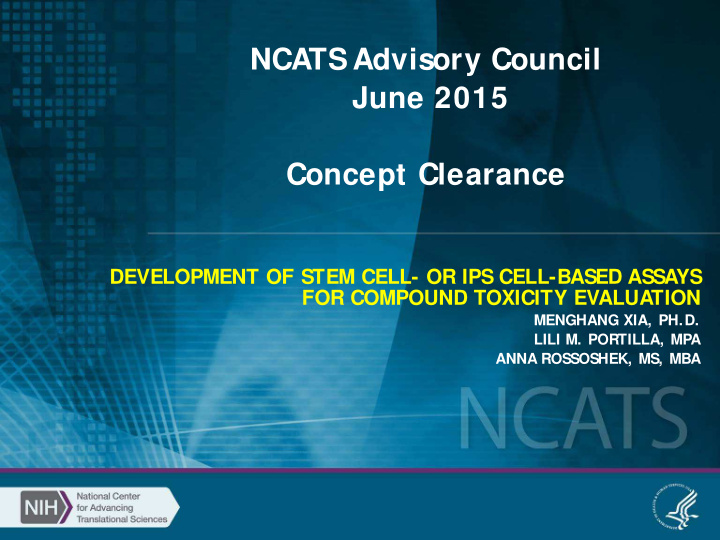



NCATS Advisory Council June 2015 Concept Clearance DEVELOPMENT OF STEM CELL- OR IPS CELL-BASED ASSAYS FOR COMPOUND TOXICITY EVALUATION MENGHANG XIA, PH.D. LILI M. PORTILLA, MPA ANNA ROSSOSHEK, MS, MBA
Description of the Goal • For the Phase I cont ract , t he goal is t o develop t oxicological relat ed assays in homogenous format t hat can be used in human st em cell or iPS -derived cells wit h short t ime compound t reat ment . • For Phase II cont ract s, t he goal is t o miniat urize t he assays int o 384-well and 1536-well plat e format .
Description of the Outcome • Potential impact? Assays wit h various endpoint s using iPS -derived cells in a 1536-well plat e format will great ly speed up t he capacit y of screening environment al chemicals. Also, using iPS -derived st em cells will make t his screening approach even more relevant and t he dat a more valuable in order t o est ablishing predict ive models of how t hese chemical compounds affect human t issues and pat hways.
Description of the Outcome • Criteria for evaluating success? The number of solicit at ions received wit h innovat ive approaches. Technical achievement in growing and ut ilizing iPS derived st em cells for HTS in miniat urized assay plat es. A viable iPS / st em cell assays t hat meet s all t he appropriat e charact erizat ion crit eria, i.e. sensit ivit y, Z’ value >0.5 Demonst rat es significant ut ilit y of t he assay by charact erizing it s abilit y t o det ect t he effect s of compounds known t o affect t he pat hway/ cellular phenot ype.
Description of the Initiative • What is the major obstacle/opportunity to address? Using iPS cells in toxicological screens therefore making them more relevant in-vitro model systems for the future. • Relevance to the NCATS’ mission? These assays would be the basis for screening programs such as the Tox21 Program and other qHTS initiatives. • Brief summary of ongoing research/activity in this area? This proposed contract topic is closely related to a previous S BIR contract topic entitled, “ Assay Development for High-Throughput S creening of Chemicals of Toxicological Concern” which has successfully produced several new assays to be commercialized by small businesses.
Recommend
More recommend